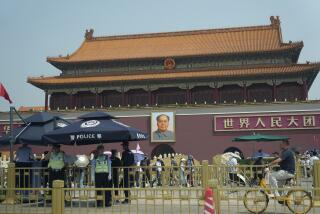Deng’s ‘Re-Education Drive’ Aimed at Bolstering His Vision of China
- Share via
BEIJING — Despite the sweltering August heat, thousands of Chinese poured into the People’s Revolutionary Military Museum for the daily dose of official culture and history.
They filed past glass cases containing blood-soaked army T-shirts, charred rifles, Molotov cocktails, broken bits of bricks, smashed loudspeakers, cracked helmets and crumpled shields. They were led into a makeshift theater where they were shown the government version of the pro-democracy student protests that were broken up June 3-4 with much bloodshed.
They were led past wallboard exhibits that describe the “heroics” of the People’s Liberation Army in the crackdown, an action that Western analysts and independent observers describe as a massacre.
Through it all, the visitors remained silent. Only a few were bold enough to remark that visiting the museum was not their idea.
The museum’s hospitality guide told two visiting Americans on Monday that more than 1 million people have now seen the two-week-old “Turmoil Exhibit,” or, as it is called officially, the “Exhibit of the Quelling of the Counterrevolutionary Rebellion.” Attendance is mandatory for all Beijing workers as part of the new leadership’s national re-education process, which the government calls “cultural rectification.”
Although different in ideology and scope from Mao Tse-tung’s Cultural Revolution of the 1960s and ‘70s, the campaign under the leadership of Deng Xiaoping is aimed chiefly at reinforcing Deng’s vision of Chinese society and the Communist Party of China.
Deng’s campaign has targeted everything from literature and journalism to pornography and pop music, from political ideology to video games, from movie houses to tea rooms.
Under Deng’s direction, the orthodox party hierarchy has used a dual strategy of censorship and substitution to carry out its campaign. The casualties have been human as well as material.
Writers, Historians Targeted
In June, when the party leadership started its crackdown on the liberal and progressive forces of Zhao Ziyang, the ousted party chief, many of Zhao’s supporters in the political hierarchy were purged. But in the last month several key writers, historians and ideologues in the government’s Ministry of Culture and the Press and Publications Administration--the powerful censorship bureau--have also been fired.
Reliable sources said Monday that the leadership has decided to replace the minister of culture as well as two vice ministers, including Ying Ruocheng, who gained world fame as the gentle prison warden in the Academy Award-winning film “The Last Emperor.”
Ying, whose movie character was purged in the Cultural Revolution, was personally criticized by the party’s aging conservatives when the film was being made because he helped arrange for it to be filmed inside Beijing’s Forbidden City. Nonetheless, he kept his government post as vice minister of culture.
Ying’s pending, real-life purge is seen by several Chinese artists as an especially bitter example of life imitating art.
Culture Minister Wang Meng, who was removed last week from his post as secretary of the party’s cultural committee because of his liberal ideas, is soon to be replaced as minister by a hard-liner with a background in propaganda, the sources said.
On the material side, the campaign has been even more sweeping.
It has been extended to virtually every province, and millions of copies of books, magazines and video and audio tape cassettes have reportedly been confiscated or destroyed. Booksellers have been fined or jailed. New museum exhibits are carefully screened, as are all new films and publications.
In announcing developments in the campaign, the state-run New China News Agency has said repeatedly that the materials confiscated or destroyed were found to be “vulgar” or “anti-communist” or to be based on “pornography, feudal superstition or bourgeois liberalization.”
In one province, hundreds of videocassettes deemed pornographic were publicly crushed by a steamroller. In another, thousands of copies of outlawed magazines were burned.
The official news agency reported that in the city of Xian, “pornographic publications . . . suffered a disastrous fate” when 4,000 government agents raided 900 bookstalls and confiscated tens of thousands of books, magazines and tapes.
The government has taken to calling such material “cultural opium.”
Political Indoctrination
The hard-liners have not stopped at confiscation and prosecution. They have devised a vast array of neo-conservative cultural programming for “misguided” party members and government workers. This program of substitution has been as intensive as the purge.
Journalists, editors and educators have been subjected to frequent political indoctrination seminars. Party instructors have lectured dancers, singers and actors in ballrooms and tea houses. Government censors have inspected video-game parlors for games with sexual or political overtones and have replaced many with games considered ideologically respectable.
The most intensive substitution programs have been concentrated in Beijing, the center of the student unrest.
Tian An Men Square, which was the focal point of the student activity, is closed to the public, but it was filled this week with hundreds of movie actors and extras for the filming of a government television special to be aired over several days leading up to the 40th anniversary of the founding of the People’s Republic on Oct. 1.
The film, one of several recent government productions, reportedly will emphasize the need for strict adherence to the pure ideology that was the backbone of the Chinese Communist revolution.
Another recent government film, “The 100 Colors Uprising,” glorifies the 84-year-old Deng Xiaoping as a young revolutionary who led a key battle against the nationalist forces in the late 1920s. Now in its third week in theaters throughout the country, the film has been required viewing for government workers, who are given free tickets.
Whether the campaign is having any effect on a population that has been exposed to years of reform under Zhao and other progressives is not clear.
A taxi driver who had a copy of a banned book, a paperback detective story entitled “The Case of China’s Biggest Con Man,” laughed when he was asked how he had managed to buy a book that was banned.
“It’s easy,” he said. “All the booksellers still have them. You just ask for a ‘yellow’ book, show your identity card to prove you don’t work for the police, and you buy it.”
Book on Crafty Embezzler
Such “yellow” books are not really pornographic, the cabbie said. His book, he said, tells of a crafty Chinese citizen who embezzled nearly $20 million without getting caught. It is plots like this, he said, that account for the popularity of such books.
“When people read the book, they think this guy is really cool,” he said.
But there is another reason for what he and several other Beijing residents called a resurgence in the popularity of such books, and it bodes ill for the success of the government’s cultural rectification campaign.
“The main reason,” the driver said, “is that as soon as the government bans a book or a magazine, for whatever reason, the first thing people want to do is run out and buy it. People think there must be some great, mysterious reason why it has been banned, and they want to get it before it’s sold out.”
More to Read
Sign up for Essential California
The most important California stories and recommendations in your inbox every morning.
You may occasionally receive promotional content from the Los Angeles Times.









